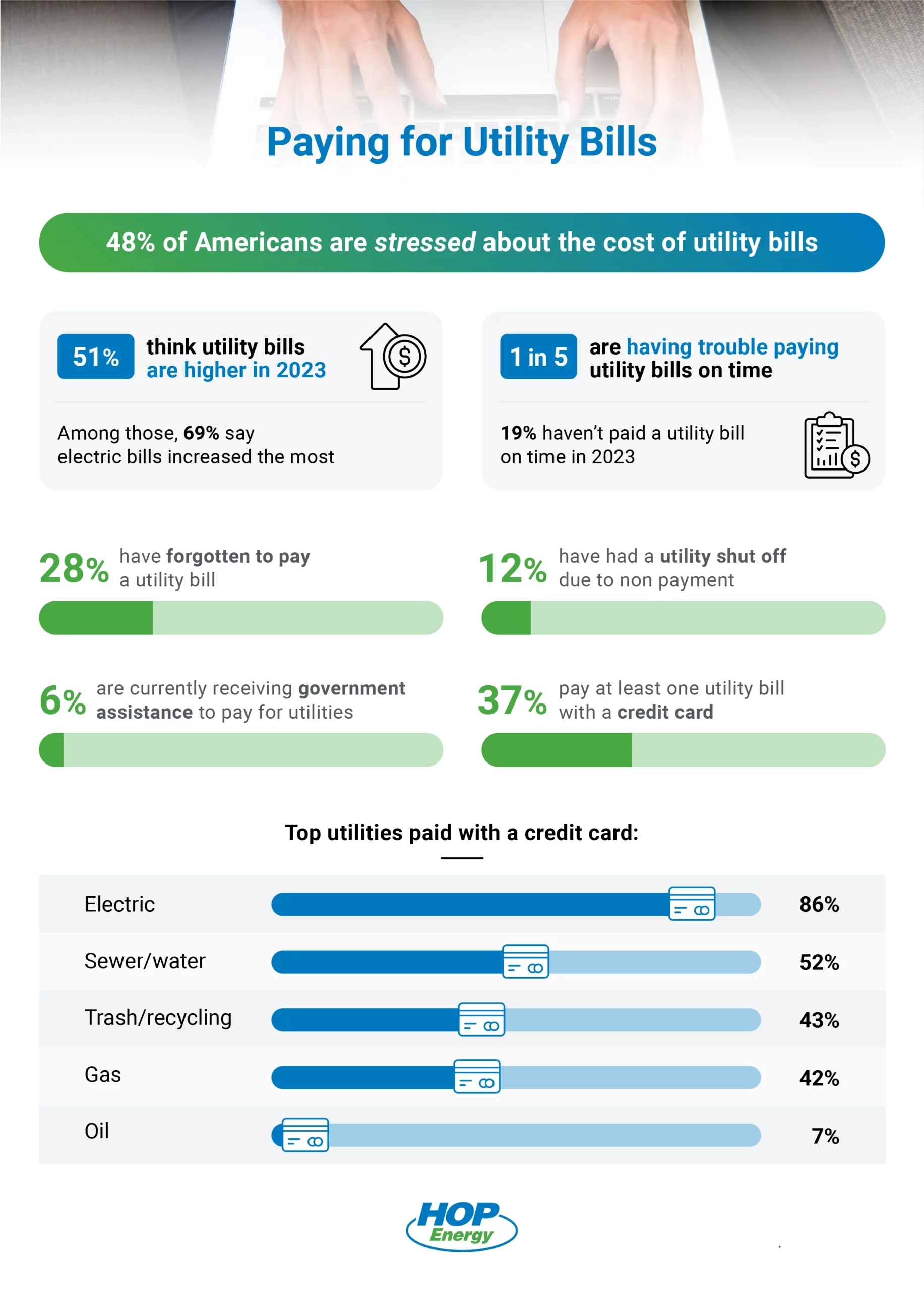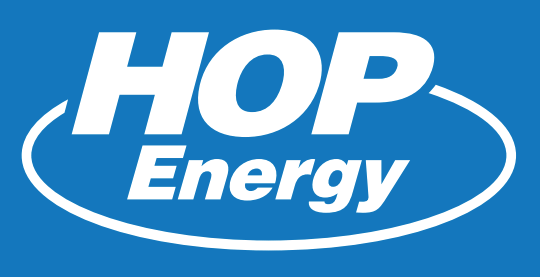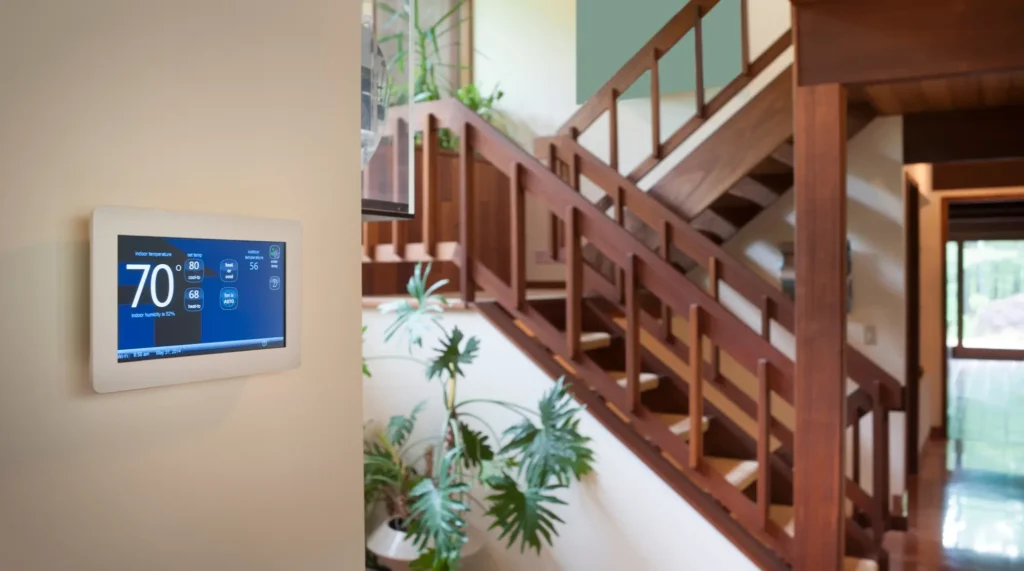With winter here, home heating costs are rising nationwide, and many Americans are spending more time inside their homes. This can affect utility bills as the lights stay on longer and more energy is required to heat homes as temperatures drop outside.
What are utility bills doing to American budgets? We wanted to know how Americans are feeling about their utilities, so we surveyed 1,002 across the nation on how much difficulty they’re having paying their bills – and whether or not they could accurately guess the cost of each of their utilities. For the purposes of this study, we stuck to examining primarily electric, gas, and oil utility bills.
Table of Contents
Many Americans are Struggling to Pay Utility Bills

The cost of living has increased quite a lot in the last few years, and Americans are still feeling the squeeze of inflation in all aspects of their lives– utility bills are no different. 48% of Americans are stressed about the cost of their utility bills, and 1 in 5 are having trouble paying bills on time, with a similar number (19%) having been late on at least one utility in 2023.
Utility bill stress isn’t unwarranted, either: inability to pay can create dire consequences. A danger of nonpayment of utility bills is eventual shut off; of those surveyed, 12% have had a utility bill shut off due to nonpayment at some point in their lives. There is good news, however: hardship funds for utility bills in the form of government assistance is typically available, and 6% have taken advantage of that. Knowing that there’s a safety net can certainly help relieve that utility bill anxiety!
Over half of Americans feel that utility bills are higher in 2023 than in past years. It seems nearly 7 in 10 are asking themselves “Why is my electric bill so high?”– 69% say that of all utility bills, electric bills increased the most.
Paying bills monthly can be a hassle- 28% have forgotten at least once to pay a utility bill on time, and autopay remains an appealing option for many.
Over 1 in 3 Americans pay at least one utility with a credit card rather than direct debit from a bank, and of those, 86% do so for their electric bills, followed by just over half for their sewer and/or water bills. Trash and recycling barely beats out gas when it comes to credit card payments, while only 7% use a card for their oil payments.
Estimated versus Actual Utility Bill Costs by Utility
It turns out Americans are accurate- the average monthly utility bill for gas, electric, and oil was only off by a small percentage from what Americans had estimated. They averaged an inaccuracy of less than $10 across all utilities, with oil having the largest difference between estimation (Americans underestimated by an average of $17) and gas having the smallest, with an average discrepancy of $1.
Youth might have some advantages, but utility knowledge isn’t one of them: 56% of Gen Z underestimated their utility bills.
Overall, 22% of Americans pay a flat rate on at least one utility, and half use autopay for at least one utility bill.
We also examined some deeper demographic information to determine which type of homeowner was most and least accurate overall, as well as which type of homeowner overestimated or underestimated the most:
- Greatest percentage of homeowners who were accurate: Mobile Home (63%)
- Least accurate homeowners: Single Family Homeowners (39%)
- Largest percentage overestimating: Townhome (41%)
- Largest percentage underestimating: Multi-family homeowner (39%)
How did Americans feel about this estimation exercise? 1 in 5 were surprised about how high their utility bills were. As for the rest:
Accuracy might have won out at 40% of respondents claiming those bragging rights, but nearly 1 in 3 underestimated, and 28% overestimated their bills.
Top 10 Ways Americans are Cutting Utility Costs in 2024
71% of Americans are trying to cut costs in 2024.
Given so many are stressed or struggling about their bills, it’s no surprise that over 7 in 10 are planning on cutting costs on utilities in 2024. Of those, the vast majority are focusing especially on cutting electricity consumption, followed by water, natural gas, trash, and finally heating oil.
Nearly 3 in 5 Americans will be adjusting their thermostats in 2024 to being closer to the outside temperature; this is the most popular way to cut utility costs in 2024. After that, just over half will unplug items not in use, and 45% will use energy efficient lightbulbs like LEDs in lieu of the traditional incandescent bulb. 43% will take shorter showers, and a similar percentage are planning on using less hot water. Two in five will keep unused rooms closed to concentrate heat, while 29% are planning on winterizing the home. Finally, 28% will be acquiring energy-efficient appliances.
4 Things Experts Recommend to Cut Utility Costs in 2024
What do experts recommend to cut utility costs in 2024? HOP Energy recommends these 4 ways to save:
1) Programmable Thermostats
Programmable thermostats provide the convenience of scheduling temperature changes to optimize the efficiency of your heating system. These devices can be set to reduce the temperature during times when you are not at home or while sleeping, leading to energy conservation and financial savings.
2) Zone Heating
Zone heating focuses on warming specific sections of your home instead of the entire area. This can be accomplished through zoned HVAC systems, the use of space heaters, or the installation of fireplace inserts. By targeting heating to only used areas, zone heating can lead to considerable reductions in heating costs, as it minimizes the energy spent on heating unoccupied spaces.
3) Proper Insulation
Effective insulation is essential for maintaining energy efficiency in a building. It involves insulating walls, attics, and floors, as well as meticulously sealing any gaps. Key actions include enhancing attic insulation, sealing openings around doors and windows, and installing energy-efficient windows. These improvements are vital for minimizing heat escape and consequently lowering heating costs.
4) Weatherization
Weatherization involves a set of strategies aimed at enhancing a building’s energy efficiency. This process typically involves sealing gaps with caulking and weather-stripping, adding insulation to attics and basements, ensuring ductwork is airtight, and replacing or upgrading doors and windows. By implementing these measures, heat loss and air drafts are significantly reduced, resulting in decreased heating expenses.
With winter here, keeping your home warm is incredibly important, and HOP Energy offers a variety of services to help- from delivering oil to installing new HVAC, heat pump, or furnace systems. Don’t forget to schedule your oil or propane deliveries!
Methodology
In December 2023, we surveyed 1,002 homeowners about their recent utility bills as well as their thoughts and feelings on utilities generally. Respondents ranged in age from 18 to 81 with an average age of 46, and 50% were men, 49% were women, and 1% were either nonbinary or preferred not to say.
83% were single-family homeowners, 3% multifamily homeowners, 4% apartment owners, 4% townhome owners, 3% condo owners, and 4% mobile home owners.
Fair Use
When using this data and research, please attribute by linking to this study and citing HOP Energy.




